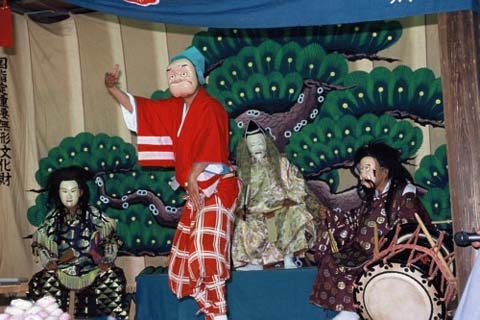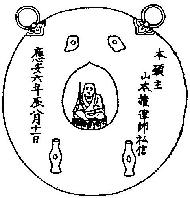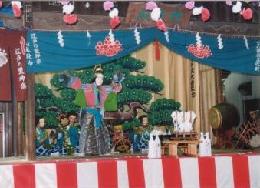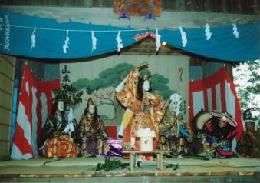Last updated: June 7, 2019
The Anazawa Tenjin Shrine festival in 2019 will be held on August 25th (Sunday).
Edo no Sato Kagura can be seen at the Kagura Hall inside Anazawa Tenjin shrine from around 1pm.

Edo no Sato Kagura
Kagura is a performing art that originated in ancient times and is said to have the oldest history among the folk performing arts. Its origin is that it was performed to console divine spirits, and was a dance dedicated to the gods. The word kamukura, which means ``the seat of a divine spirit when it invites a god,'' is thought to be the origin of the word kagura.
Kagura, which originated in ancient times, spread throughout the city of Edo in the early Edo period, and changed into various forms depending on the tastes of the common people of Edo. One of these is the Sato Kagura of Edo, which was actively performed at shrine festivals in Edo and surrounding villages. The distinctive feature of Edo no Sato Kagura was that it was a silent theater (mokugeki) with masks, and it was mainly performed with themes from the world of mythology. Another reason is that the performers were full-time kagura performers.
Currently, four Edo no Sato Kagura styles have been handed down in Tokyo. These are Mamiya Shachu (Shinagawa Ward), Wakayama Shachu (Taito Ward), Matsumoto Morichu (Arakawa Ward), and Yamamoto Morichu in Inagi City. All four shrines have been designated as nationally important intangible folk cultural properties.
Edo-no-Sato Kagura at Yamamoto Yorinobu Shrine was founded in 1373 in the early Muromachi period by Yamamoto Gonritsushi Hironobu. It is said that the current head of the family, Mr. Yorinobu Yamamoto, is in his 19th generation. It is said that Kagura was first performed at Kuniyasu Shrine, which was near the Yamamoto family, and is included in the Edo Meishozue (Illustrated Guide to Famous Places of Edo) (published in 1970 by Tenpo). , Kuniyasu Shrine and the Kariden and Shajin buildings are depicted, and the building depicted as Kariden functions as a prayer hall, where various prayers are held. It is thought that it was used as a place for dancing and kagura.
In addition to the Kagura script called ``Shinji Shiki Meiroku,'' which is thought to be a manuscript from the mid-Edo period, the Yamamoto family also has a script for ``Iwai Shinto Forest'' written in 1769. Numerous materials remain, including an ancient document called ``Iwaijinja Suzugamori Kagura Kakushiki'' (which describes the Kagura program, items to bring, and appearance). These materials show that Sato Kagura has been passed down from the Edo period to the present day. It is also recorded that around the middle of the Edo period, there were 50 Sato Kagura performers.
Currently, Yamamoto Yorishinsha Junior High School performs Sato Kagura in more than 40 theaters, and the following are some of the most representative performances.
[Classical items] Ame no Ukihashi, Yomotsu Shikome, Suminoe no Okami, Yakumo Jinei, Amanoiwa Door ), Kengyoku Seijin, Kanyaraimikasa, Amano Kaeshiya, Yugenbunkai, Tenson Kourin , Kasasakuragari, Sankai Koeki, Youzoku Senmetsu, Miwa Kansugi, Saho Subjugation, Bear Kumaso Seibatsu, Toi Seibatsu, Sakaori Renga, Keitei no Saguriyu, Ihihoraku, Keishin Aiko ), Mihogasaki Fishing (Mihogasaki Uotsuri)
[Modern] Autumn leaves viewing (Momijigari)
[Fairy tale] Inaba's white rabbit

Kuniyasu Shrine Deity Statue (Edo Meisho Zue)

Kuniyasu Shrine and Temporary Hall (Edo Meisho Zue)

Shiki-sanban of "Sumie Okami"

Gods of "Amanoiwa Door"
Inagi City Education Department Lifelong Learning Division Tel: 042-377-2121